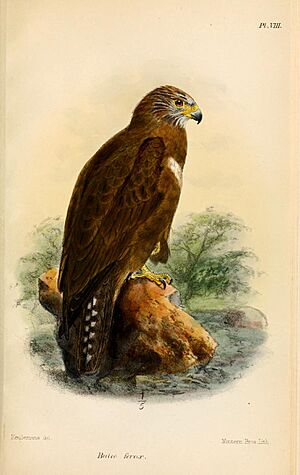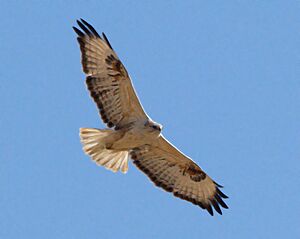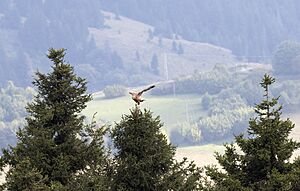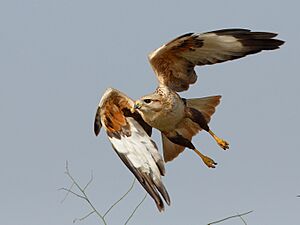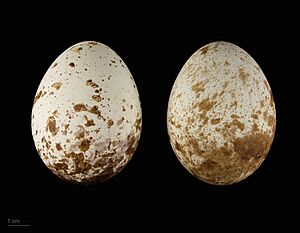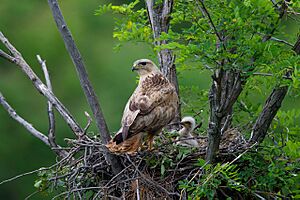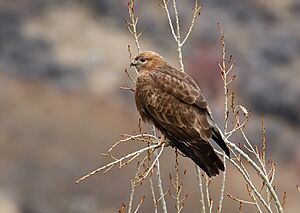Long-legged buzzard facts for kids
Quick facts for kids Long-legged buzzard |
|
|---|---|
 |
|
| Conservation status | |
| Scientific classification | |
| Subspecies | |
|
|
 |
|
| Range of B. rufinus Breeding Resident Passage Non-breeding | |
| Synonyms | |
|
The long-legged buzzard (Buteo rufinus) is a large bird of prey. You can find it in many parts of Eurasia and North Africa. This bird lives from Southeastern Europe all the way to East Africa and the northern Indian subcontinent.
It is one of the bigger types of buzzards. Even though it is strong, it often seems quite slow. Like most buzzards, it mostly eats small mammals. These include rodents like gerbils, ground squirrels, voles, and rats. They also eat reptiles, other birds, and insects. Sometimes, they even eat carrion (dead animals).
Long-legged buzzards can live in many different places. They build their nests on rocks, cliffs, or in trees. Their breeding habits are similar to other buzzards. This species is found in many areas and its population seems to be stable. Because of this, the IUCN lists it as a species of Least Concern.
Contents
About the Long-legged Buzzard

What it Looks Like
The long-legged buzzard is a large and strong bird. It has a big beak on a small head. Its wings are long, and its tail is quite long too. It also has long legs with strong feet.
These buzzards often seem a bit lazy. They like to sit out in the open on a rock, cliff, or power pole. From these high spots, they can see everything around them. They also walk slowly on the ground, sometimes waddling a bit.
Their feathers can look very different from one bird to another. There are usually three or four main types, called morphs.
- Pale morph adults have light, plain heads. Their bodies are dark brown with sandy streaks. Their tails are light orange-red.
- Intermediate adults are similar but have richer, darker colors.
- Rufous morphs are more orange-brown overall.
- Dark morph adults are almost all blackish-brown. Their tails are grey with a wide dark band.
Young buzzards (juveniles) look similar to adults of their morph. However, their feathers are often neater and paler. Their eyes are pale grey or yellowish, turning dark brown as they get older. Their beak and legs are dull yellow.
How it Flies
When flying, the long-legged buzzard looks like a medium-sized bird with a wide body. It can almost look like an eagle. It has a head that sticks out and long, wide wings. Its tail is fairly long and rounded.
Young buzzards look a bit slimmer when they fly. They have narrower wings and a slightly longer tail. Long-legged buzzards usually fly with slow, deep wing beats. They also glide with their wings held up in a shallow 'V' shape. They often hover in the air for a long time.
In flight, their light orange tail often looks white from far away. This makes it stand out against their dark body and wings.
How Big it Is
This buzzard is one of the biggest in the Buteo family. Only a few other buzzards, like the upland buzzard and ferruginous hawk, are bigger or similar in size.
Long-legged buzzards can be from 50 to 66 cm (20 to 26 in) long. Their wings can spread from 112 to 163 cm (3 ft 8 in to 5 ft 4 in) wide. The average wingspan is about 145 cm (4 ft 9 in). Female buzzards are usually bigger than males. They can be up to 15% larger and 30% heavier.
Males usually weigh around 1,035 g (2.282 lb). Females are heavier, averaging about 1,315 g (2.899 lb).
How to Identify It
It can be tricky to tell long-legged buzzards apart from other birds. This is because their feathers vary so much. People often confuse them with the common buzzard, especially the steppe subspecies.
Here are some ways to tell them apart:
- Steppe buzzards have darker heads and chests. Their tails are fully barred and darker. They are also smaller and have shorter wings and tails. Steppe buzzards fly with faster, stiffer wing beats.
- Upland buzzards are slightly bigger. They usually have a large white patch on their wings and a plain greyish-white tail. They also lack the warm, reddish colors of the long-legged buzzard.
- Rough-legged buzzards are similar in size and flight. But they have a white tail with a broad dark band at the end. Their legs are also fully feathered.
Other large birds of prey, like small eagles, can sometimes be confused with them. However, most other raptors have different shapes, especially their wings, heads, and tails.
Its Voice
The long-legged buzzard is not known for being very noisy. It sometimes calls when it is displaying in the air. Its call is similar to the common buzzard but shorter and higher. The most common call is a short mew. It can also sound like a kyaaah that drops in pitch. Some people say its calls are more like a gull than a squealing sound.
Where it Lives and Its Home
Distribution
The long-legged buzzard lives in dry areas. These include northern Africa, southeastern Europe, and parts of Asia all the way to China and central India.
- In Africa, they breed in Western Sahara, Morocco, Algeria, Tunisia, and Libya.
- In Europe, they mainly nest in the southeastern parts. This includes Hungary, Ukraine, Moldova, Romania, Serbia, Bulgaria, and Greece. They have also started nesting in southern Italy and Spain. Sometimes, they are seen by accident in other European countries like Finland or France.
- In the Middle East and Asia Minor, they are common in Turkey, Cyprus, Armenia, Georgia, and Azerbaijan. Their range also goes into southwestern Russia.
- They are found throughout much of the Middle East, including Syria, Lebanon, Israel, Iraq, and Iran. They also live in Oman, the United Arab Emirates, Yemen, and Saudi Arabia.
- Their range continues through most of Central Asia, including Turkmenistan, Uzbekistan, Kazakhstan, Tajikistan, and Kyrgyzstan. They also live in northern and central Afghanistan.
Many long-legged buzzards that breed in Europe, Russia, and Central Asia fly south for the winter. They spend winter in places like the Indian subcontinent, including Pakistan and northern India. They also winter in parts of Africa, like Sudan and Ethiopia.
Habitat
Long-legged buzzards prefer open, wild areas. They like places with tall bushes, trees, cliffs, or hillocks for nesting. They also need access to fresh water.
They usually live in steppe (grassy plains), semi-desert, and desert edge areas. They also like rocky landscapes and dry shrubland. Sometimes, they live near sea coasts. They can adapt to woodlands if there are enough open spaces. Slightly hilly plains are perfect for nesting.
Even though they mostly hunt in wild areas, they can also adapt to farms, pastures, and even near villages. In winter, they often use Grasslands. In India, they use dry forests with open areas and bare hillsides. They often sit on bushes, sand dunes, or power poles.
These buzzards can live from sea level up to about 1,600 m (5,200 ft) in Europe. In Asia, they can be found in mountains up to 3,000 m (9,800 ft) or even 3,900 m (12,800 ft). Migrating birds have been seen as high as 5,000 m (16,000 ft).
Family Tree and Types
The long-legged buzzard belongs to the Buteo genus. This group of birds started in the Americas. The Buteo genus has almost 30 different species.
The upland buzzard was once thought to be the same species as the long-legged buzzard. However, genetic studies show they are not closely related. They usually live in different areas. Sometimes, these two species can breed together.
Long-legged buzzards have also been seen breeding with common buzzards in places like Gibraltar.
Subspecies
There are two main types, or subspecies, of long-legged buzzards:
- Buteo rufinus rufinus: This is the most common type. It lives from The Balkans in Europe all the way east to Mongolia and India. In winter, it flies to parts of South Asia and Africa. Most of the descriptions you read about long-legged buzzards refer to this type.
- Buteo rufinus cirtensis: This type lives in northern Africa, from Mauritania east to Egypt and the Arabian Peninsula. It has also been seen in southern Israel and the Gibraltar area in Europe. Some scientists think this might be a separate species. However, because both types vary so much and are similar in behavior, voice, and looks, they are still considered subspecies. This type is smaller than B. r. rufinus. It is also paler overall and has a more reddish belly. Unlike the other type, B. r. cirtensis usually stays in one place and does not migrate.
Migration and Travel
The North African long-legged buzzards usually stay in their home areas. But some may travel short distances, even to Iberia (Spain and Portugal).
The main type, Buteo rufinus rufinus, mostly stays put in the southern parts of its range. However, those in the north and east almost always migrate. They start flying south in late August or September. They usually travel alone or in small groups.
They typically arrive in the Indian subcontinent by September or October. They leave by March. Many buzzards spend the winter in the eastern Mediterranean, the Middle East, and parts of Asia. Some also winter in Africa, mainly in the Nile Valley in Sudan.
They start flying back to their breeding grounds in late February. This return journey peaks in the second half of March. By March or mid-April, they are usually already starting to breed.
What the Long-legged Buzzard Eats
Even though they are often called sluggish, long-legged buzzards are active and strong hunters. They often hunt by pouncing on prey from a high spot. They can sit for a long time on power poles, rocks, or trees, looking for food. They also watch for prey while standing on the ground, sometimes right by an animal's burrow.
They also hunt while flying. They can hover in the air, sometimes as high as 30 m (98 ft) above the ground. Then they drop quickly to catch their prey. The way they hunt depends on where they are and what kind of perches are available. They prefer to hunt in open areas like grassy plains or dry semi-deserts.
Sometimes, they even visit wildfires to catch animals trying to escape. They often do this with other birds of prey.
Their diet is typical for a Buteo. They eat many different things, but they prefer small mammals. They also eat a lot of reptiles, from small to quite large. Other foods include birds, insects, and other small creatures. They rarely eat other types of vertebrates.
Long-legged buzzards usually eat animals that weigh between 20 g (0.71 oz) and 1,500 g (3.3 lb). They also eat carrion (dead animals), especially in winter.
Favorite Foods

In Ukraine, their main prey are common voles and greater mole-rats. These small mammals make up a large part of their diet. They also eat speckled ground squirrels and young European hares.
In Hungary, they sometimes eat a lot of beetles. But European ground squirrels are also a common food. In Bulgaria, they eat Microtus voles, ground squirrels, and brown rats. They also eat Balkan green lizards.
In Georgia, they mostly eat very small mammals like social voles and house mouses. In Armenia, their diet is very reptile-based, including many lizards. On the island of Cyprus, their main foods are black rats and starred agama lizards.
In Israel, they mostly eat Schneider's skinks and starred agamas. They also eat many birds, like rock doves. In Jordan, fat sand rats are a main food. In Iran, they eat Caucasian squirrels and different types of agama lizards.
In Kazakhstan, they eat Tamarisk gerbils and red-cheeked ground squirrels. In Russia, their diet is more varied. They eat larks, young European hares, social voles, and even adult rooks. In China, great gerbils are a main food, along with Tartar sand boa snakes.
In India, they eat many small mammals, especially Indian desert jirds. They also eat lizards like Indian spiny-tailed lizards and other agamas, as well as snakes.
Sharing Their Home
Long-legged buzzards live in many places across Eurasia. They often share their habitat with common buzzards. Long-legged buzzards prefer open, rocky areas, while common buzzards like wooded edges.
They also share their hunting grounds with other birds of prey. These include smaller harriers and larger eagles like eastern imperial eagles and steppe eagles. They also live near saker falcons. Saker falcons often use old long-legged buzzard nests.
Sometimes, long-legged buzzards compete for food with short-toed snake eagles. Even though the snake eagle is bigger, the buzzard is often faster and more aggressive.
Their main predator is the Eurasian eagle-owl. Other large raptors, like eastern imperial eagles and Bonelli's eagles, also sometimes hunt them. Long-legged buzzards have also been known to hunt other birds of prey, including different types of sparrowhawks, owls, and falcons. They also sometimes eat small mammal carnivores like least weasels.
Reproduction and Life Cycle
Long-legged buzzards usually live alone or in pairs. But sometimes, they form loose breeding groups. Several pairs might nest close together, even as close as 300 m (980 ft). When they migrate, they sometimes travel in small groups.
During courtship, males and females fly high in circles. They dive at each other. The male also performs an amazing "sky dance." He circles high, then plunges down with partly closed wings, swooping back up. He might even do loops in the air.
Their breeding season changes depending on the area.
- In Europe, they usually breed from March to July.
- In the United Arab Emirates, eggs have been reported as early as December.
- In Morocco, courtship starts in January or February. Eggs are usually laid from March to April.
- In Pakistan, the nesting period is from March to July.
The nest is a large pile of sticks and branches. It is usually lined with green leaves, twigs, straw, and wool. Nests are quite big, often around 71 to 99 cm (28 to 39 in) wide. Some can be over 1 m (3.3 ft) across.
They often build nests on cliff ledges, rocks, or in granite niches. In Kazakhstan, most nests are on ledges. In Cyprus and China, most nests are on cliffs. In Bulgaria, if there are no natural rocks, they might nest in man-made quarries. In Ukraine and Russia, they often build nests in trees like oaks or apple trees. Some nests have even been found on old buildings.
Sometimes, they use old nests built by other birds, like common ravens. They often reuse their nests year after year, adding more material each time.
Long-legged buzzards usually lay 2 to 4 eggs. But they can lay from 1 to 6 eggs. The eggs are slightly rough and oval. They are mostly whitish with a yellowish tint and some faint brown or reddish-brown markings. The eggs are about 59.5 mm × 46.9 mm (2.34 in × 1.85 in) in size.
The parents take turns sitting on the eggs for about 28 to 30 days.
Chicks and Fledging
When the chicks hatch, they are covered in fine white down. The mother usually broods them (keeps them warm) for about 30 days. After that, she might start hunting again. The young buzzards can fly (fledge) when they are between 40 and 46 days old.
After leaving the nest, the young birds stay with their parents for about a month. This is longer than some other birds in temperate areas.
The success rate of their breeding varies. In Cyprus, it ranged from 46% to 93%, depending on how much food was available. In China, about 0.7 young birds flew from each nest on average.
Conservation Status
In some areas, like western Russia, the number of long-legged buzzards has gone down. They might be less common in the western parts of their range than they used to be.
However, since the 1990s, their numbers have increased in Europe. This is especially true in Bulgaria. Their population is growing and they are spreading into new areas like the Hungarian steppes.
In the 1990s, there were an estimated 5,000 to 15,000 breeding pairs in Europe. By 2015, this number grew to 11,800 to 19,200 pairs.
- About 800-1500 pairs nest in western Russia.
- 200-750 pairs are in Bulgaria.
- 60-300 pairs are in Greece.
- About 50 pairs are in Ukraine.
Even with these increases, Europe has less than a quarter of the world's population. Their numbers are still over 30% lower than they used to be. So, in Europe, the long-legged buzzard is considered a Vulnerable species.
In Israel, about 500 pairs nest. Their population had dropped in the 1950s due to pesticides, but it has recovered. Turkey has a large population, likely between 3,000 and 6,000 pairs. Azerbaijan has about 1,000 to 2,500 pairs. Their numbers in Armenia are stable.
Less is known about their populations in North Africa. There might be 400 pairs in Tunisia and over 1,000 in Morocco. A small number nest in the Arabian Peninsula. The population in Arabia might have dropped by 5%. This could be because their habitat is being turned into farmland or stone quarries. Saudi Arabia has about 600 pairs, Oman and Yemen each have about 100 pairs, and the United Arab Emirates has about 5 pairs.
Fewer numbers are known from Asia. They are uncommon to rare in Pakistan and northwestern China. But there is good evidence that many pairs breed continuously in Central Asia.



